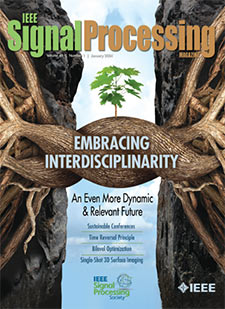- Our Story
- Publications & Resources
- Publications & Resources
- Publications
- IEEE Signal Processing Magazine
- IEEE Journal of Selected Topics in Signal Processing
- IEEE Signal Processing Letters
- IEEE/ACM Transactions on Audio Speech and Language Processing
- IEEE Transactions on Computational Imaging
- IEEE Transactions on Image Processing
- IEEE Transactions on Information Forensics and Security
- IEEE Transactions on Multimedia
- IEEE Transactions on Signal and Information Processing over Networks
- IEEE Transactions on Signal Processing
- IEEE TCI
- IEEE TSIPN
- Data & Challenges
- Submit Manuscript
- Guidelines
- Information for Authors
- Special Issue Deadlines
- Overview Articles
- Top Accessed Articles
- SPS Newsletter
- SigPort
- SPS Resource Center
- Publications Feedback
- Publications FAQ
- Blog
- News
- Dataset Papers
- Conferences & Events
- Community & Involvement
- Professional Development
- For Volunteers
- Information for Authors-OJSP
-
Home
Conferences Events IEEE JSTSP Article IEEE Signal Processing Magazine IEEE TIFS Article IEEE TMM Article IEEE TSP Article Jobs in Signal Processing Lectures Machine Learning Seasonal Schools Signal Processing News SPM Article SPS Distinguished Lectures SPS Newsletter Article SPS Webinar SPS Webinars SPS Webinar Series Webinar webinars
-
Our Story
What is Signal Processing?

The technology we use, and even rely on, in our everyday lives –computers, radios, video, cell phones – is enabled by signal processing. Learn More » -
Publications & Resources
-
SPS Resources
- Signal Processing Magazine The premier publication of the society.
- SPS Newsletter Monthly updates in Signal Processing
- SPS Resource Center Online library of tutorials, lectures, and presentations.
- SigPort Online repository for reports, papers, and more.
- SPS Feed The latest news, events, and more from the world of Signal Processing.
-
SPS Resources
-
Conferences & Events
-
Community & Involvement
-
Membership
- Join SPS The IEEE Signal Processing Magazine, Conference, Discounts, Awards, Collaborations, and more!
- Chapter Locator Find your local chapter and connect with fellow industry professionals, academics and students
- Women in Signal Processing Networking and engagement opportunities for women across signal processing disciplines
- Students Scholarships, conference discounts, travel grants, SP Cup, VIP Cup, 5-MICC
- Young Professionals Career development opportunities, networking
- Get Involved
-
Technical Committees
- Applied Signal Processing Systems
- Audio and Acoustic Signal Processing
- Bio Imaging and Signal Processing
- Computational Imaging
- Image Video and Multidimensional Signal Processing
- Information Forensics and Security
- Machine Learning for Signal Processing
- Multimedia Signal Processing
- Sensor Array and Multichannel
- Signal Processing for Communication and Networking
- Signal Processing Theory and Methods
- Speech and Language Processing
- Technical Working Groups
- More TC Resources
-
Membership
-
Professional Development
-
Professional Development
- Mentoring Experiences for Underrepresented Young Researchers (ME-UYR)
- Micro Mentoring Experience Program (MiME)
- Distinguished Lecturer Program
- Distinguished Lecturers
- Distinguished Lecturer Nominations
- Past Lecturers
- Distinguished Industry Speaker Program
- Distinguished Industry Speakers
- Distinguished Industry Speaker Nominations
- Industry Resources
- IEEE Training Materials
- Jobs in Signal Processing: IEEE Job Site
-
Career Resources
- SPS Education Program Educational content in signal processing and related fields.
- Distinguished Lecturer Program Chapters have access to educators and authors in the fields of Signal Processing
- PROGRESS Initiative Promoting diversity in the field of signal processing.
- Job Opportunities Signal Processing and Technical Committee specific job opportunities
- Job Submission Form Employers may submit opportunities in the area of Signal Processing.
-
Professional Development
-
For Volunteers
-
For Board & Committee Members
- Board Agenda/Minutes* Agendas, minutes and supporting documentation for Board and Committee Members
- SPS Directory* Directory of volunteers, society and division directory for Board and Committee Members.
- Membership Development Reports* Insight into the Society’s month-over-month and year-over-year growths and declines for Board and Committee Members
-
For Board & Committee Members
Popular Pages
Today's:
- Awards & Submit Award Nomination
- Submit a Manuscript
- IEEE/ACM Transactions on Audio Speech and Language Processing
- Signal Processing 101
- Information for Authors
- SPS Scholarship Program
- IEEE Transactions on Image Processing
- Conference Call for Papers
- IEEE Transactions on Information Forensics and Security
- IEEE Signal Processing Magazine
- Conferences
- (SLT 2024) 2024 IEEE Spoken Language Technology Workshop
- (ICASSP 2025) 2025 IEEE International Conference on Acoustics, Speech and Signal Processing
- Action: Promote Half-Price Dues to Recruit New Members
- IEEE Transactions on Multimedia
All time:
- Information for Authors
- Submit a Manuscript
- IEEE Transactions on Image Processing
- 404 Page
- IEEE/ACM Transactions on Audio Speech and Language Processing
- IEEE Transactions on Information Forensics and Security
- IEEE Transactions on Multimedia
- IEEE Signal Processing Letters
- IEEE Transactions on Signal Processing
- Conferences & Events
- IEEE Journal of Selected Topics in Signal Processing
- Information for Authors-SPL
- Conference Call for Papers
- Signal Processing 101
- IEEE Signal Processing Magazine
Last viewed:
- Information for Authors-SPL
- Action: Promote Half-Price Dues to Recruit New Members
- Interspeech 2016 Highlights
- Action: Add Your Chapter Officers to Receive Important Communications
- (SiPS 2024) 2024 IEEE International Workshop on Signal Processing Systems
- IEEE Transactions on Image Processing
- The Discrete Cosine Transform and Its Impact on Visual Compression: Fifty Years From Its Invention
- Membership
- Community & Involvement
- Members
- Deep Equilibrium Architectures for Inverse Problems in Imaging
- Award Nominations
- Governance Documents
- SPTM TC Home
- Signal Processing 101
Recent Patents in Signal Processing (July 2016) – Video processing
You are here
Newsletter Menu
Newsletter Categories
Top Reasons to Join SPS Today!
1. IEEE Signal Processing Magazine
2. Signal Processing Digital Library*
3. Inside Signal Processing Newsletter
4. SPS Resource Center
5. Career advancement & recognition
6. Discounts on conferences and publications
7. Professional networking
8. Communities for students, young professionals, and women
9. Volunteer opportunities
10. Coming soon! PDH/CEU credits
Click here to learn more.
News and Resources for Members of the IEEE Signal Processing Society
Recent Patents in Signal Processing (July 2016) – Video processing
For our July 2016 issue, we cover recent patents dealing with hardware and signal processing issues of video processing. The section below covers patents granted recently for video enhancement, noise removal from videos, watermarking techniques, visual quality measurement and new video processing circuits.
The disclosure presented in Patent no. 9,374,524 relates to a method for removing noise from a digital video sequence containing a modulated light signal emitted from a beacon light source. In some embodiments, the method includes electronically receiving, by an image sensor of a device, a digital video sequence of a scene, calculating noise from the digital video sequence, wherein the noise comprises information within the digital video sequence corresponding to the un-modulated illumination of the scene, reducing the noise from the digital video sequence to obtain an isolated digital video sequence of the modulated illumination of the scene, and demodulating the emitted light signal from the isolated digital video sequence.
In Patent no. 9,369,627 a video processing apparatus includes an image capturing apparatus and a processing apparatus connected to the image capturing apparatus. The image capturing apparatus includes an image obtaining unit that obtains a frame image; a frame image transmitting unit that transmits the frame image to the processing apparatus; a transformation parameter setting unit that sets transformation parameters received from the processing apparatus in the image capturing apparatus; an image transforming unit that applies an image transformation to the frame image using the transformation parameters thus set; and a transformed frame image transmitting unit that transmits a transformed frame image to the processing apparatus. The processing apparatus includes a transformation parameter calculating unit that calculates the transformation parameters for the image transformation, using the frame image received from the image capturing apparatus; and a transformation parameter transmitting unit that transmits the transformation parameters to the image capturing apparatus.
An the invention no. 9,369,627 a video processing device overlays appropriate presentation data over video images, even if the size of the display area for 3D video images differs from the size of the display area for presentation data that is to be presented with the 3D video images. The video processing device generates left- and right-view images from a 3D video stream, enlarges presentation data obtained from a relevant data stream to scale its display size to match the display size of video images, applying an offset value, which is determined to cause a specific parallax, to the thus enlarged presentation data to generate left- and right-view presentation data, and overlays the left-view presentation data over the left-view images and the right-view presentation data over the right-view images to display video images resulting from the overlaying.
Patent no. 9,357,162 presents a method of processing digital video signals, comprising: receiving input pixels to be processed; performing multiple processing operations on the input pixels, where the multiple processing operations are performed during a time interval determined in part by a desired video output rate; and performing a classification analysis at an intermediate time during the time interval, the classification analysis yielding tag data that is used to dynamically vary one or more of the multiple processing operations, and where the tag data is generated on a per-pixel basis to enable pixel by pixel variation of the multiple processing operations.
In patent no. 9,355,426 a method, apparatus, article of manufacture, and a memory structure for inserting a watermark in a media program is described. In an exemplary embodiment, the method comprises the steps of receiving data comprising the media program in the receiver disposed at a subscriber station, generating a watermark, the watermark generated at least in part according to a secure data processor-unique identifier irreversibly stored in the secure data processor, processing the received data to reproduce the media program, and inserting portions of the generated watermark in the reproduced media program at locations determined at least in part according to the secure data processor-unique identifier to produce a watermarked media program provided for display.
The invention no. 9,355,317 is to notify a recognition result with respect to a recognition object in a video in real time while maintaining recognition accuracy. A recognition object and m-number of first local characteristic quantities which are respectively 1-dimensional to i-dimensional characteristic vectors are stored in association with each other, and n-number of second local characteristic quantities which are respectively 1-dimensional to j-dimensional characteristic vectors are generated for n-number of local areas respectively including n-number of characteristic points from an image in a video. In addition, a smaller dimension is selected from the dimension i and the dimension j, a recognition that the recognition object exists in an image in the video is made when it is determined that a prescribed proportion or more of the m-number of first local characteristic quantities which are characteristic vectors up to the selected number of dimensions correspond to the n-number of second local characteristic quantities which are characteristic vectors up to the selected number of dimensions, and information representing the recognition object is displayed in superposition on an image in which the recognition object exists in the video.
Patent no. 9,338,463 presents a measure of visual quality of processed images relative to unprocessed images is generated in real-time. The measure of visual quality closely correlates with a human's actual perception of the processed image relative to the original image. The measure of visual quality is computed based on a measure of discrepancy (e.g., mean square errors) between the processed and unprocessed images and the variance of each image in the pixel domain or the transform domain may be determined. If the processed image is unavailable, a prediction of the processed image may be used in place of the processed image. The prediction of a processed image may involve predicting the variance values for processed image blocks. The visual quality measure may be used in a feedback loop to improve processing or encoding
Based on patent no. 9,338,429, in a video processing apparatus, image information relating to a graphic image corresponding to a first video is converted using difference information calculated from first view-point information relating to a first video and second view-point information relating to a second video. A graphic image corresponding to the second video is generated based on the converted image information, and the generated graphic image and an image of the second video are synthesized.
In patent no. 9,336,741 a video processing circuit includes a boundary detection unit which detects a boundary between a first pixel in which an application voltage which is designated by a video signal Vid-in is lower than a first voltage and a second pixel which exceeds a second voltage in which the application voltage is higher than the first voltage in a normally black mode; and a correction unit which corrects a video signal in which an application voltage to a liquid crystal element corresponding to the first pixel which comes into contact with a boundary detected by the boundary detection unit is designated to be a video signal in which a correction voltage which is higher than the application voltage is designated in a part of period of one frame period, and a correction voltage which is lower than the application voltage is designated in other periods of the one frame period.
In patent no. 9,332,288 a video processing system includes a video device that generates a request corresponding to video content. A conditional access module generates a video signal for transmission to the video device during a first time period, and terminates transmission of the video signal when the request is not authenticated during the first time period. In a further embodiment, the conditional access module generates a video signal for unscrambled transmission to the video device during a first time period, terminates the unscrambled transmission of the video signal at the expiration of the first time period, and continues with scrambled transmission of the video signal after the first time period
If you have an interesting patent to share when we next feature patents related to video processing, or if you are especially interested in a signal processing research field that you would want to be highlighted in this section, please send email to Csaba Benedek (benedek.csaba AT sztaki DOT mta DOT hu).
References
Number: 9,374,524
Title: Method and system for video processing to remove noise from a digital video sequence containing a modulated light signal
Inventors: Ryan; Daniel (North Andover, MA), Staats; Peter (Wenham, MA), Sumner; Rob (Cambridge, MA)
Issued: June 21, 2016
Assignee: ABL IP Holding LLC (Conyers, GA)
Number: 9,369,627
Title: Video processing apparatus, video processing system, and video processing method
Inventors: Ishii; Masaki (Kanagawa, JP), Namie; Kenji (Kanagawa, JP)
Issued: June 14, 2016
Assignee: Ricoh Company, LTD. (Tokyo, JP)
Number: 9,369,627
Title: Video processing device and video processing method
Inventors: Uesaka; Yasushi (Hyogo, JP), Yahata; Hiroshi (Osaka, JP), Ikeda; Wataru (Osaka, JP), Ogawa; Tomoki (Osaka, JP), Ozawa; Yuka (Osaka, JP), Kawaguchi; Toru (Tokyo, JP)
Issued: May 31, 2016
Assignee: Panasonic Intelectual Property Management CO., LTD. (Osaka, JP)
Number: 9,357,162
Title: Video processing system and method with dynamic tag architecture
Inventors: Ruggiero; Carl J. (Tigard, OR)
Issued: May 31, 2016
Assignee: NVIDIA Corporation (Santa Clara, CA)
Number: 9,355,426
Title: Hardware-enforced, always-on insertion of a watermark in a video processing path
Inventors: Flaharty; Dennis R. (Shingle Springs, CA), Cocchi; Ronald P. (Seal Beach, CA), Gagnon; Gregory J. (Redondo Beach, CA), Gorman; Michael A. (Cypress, CA), Carson; Jacob T. (Long Beach, CA)
Issued: May 31, 2016
Number: 9,355,317
Title: Video processing system, video processing method, video processing device for mobile terminal or server and control method and control program thereof
Inventors: Nomura; Toshiyuki (Tokyo, JP), Yamada; Akio (Tokyo, JP), Iwamoto; Kota (Tokyo, JP), Mase; Ryota (Tokyo, JP)
Issued: May 31, 2016
Assignee: NEC Corporation (Tokyo, JP)
Number: 9,338,463
Title: Visual quality measure for real-time video processing
Inventors: Tanchenko; Alexander (Lenigrad Oblast, RU)
Issued: May 10, 2016
Assignee: Synopsys, Inc. (Mountain View, CA)
Number: 9,338,429
Title: Video processing apparatus capable of reproducing video content including a plurality of videos and control method therefor
Inventors: Umeyama; Manabu (Kawasaki, JP)
Issued: May 10, 2016
Assignee: Canon Kabushiki Kaisha (Tokyo, JP)
Number: 9,336,741
Title: Video processing circuit, video processing method, liquid crystal display device, and electronic apparatus
Inventors: Kitagawa; Taku (Shiojiri, JP), Hosaka; Hiroyuki (Matsumoto, JP)
Issued: May 10, 2016
Assignee: Seiko Epson Corporation (Tokyo, JP)
Number: 9,332,288
Title: Video processing system with conditional access module and methods for use therewith
Inventors: Gordon; Stephen E. (Lexington, MA), Karaoguz; Jeyhan (Irvine, CA), Chen; Sherman (Xuemin) (Rancho Santa Fe, CA), Dove; Michael (Los Gatos, CA), Rosmann; David (Irvine, CA), Quigley; Thomas J. (Franklin, NC)
Issued: May 3, 2016
Assignee: Broadcom Corporation (Irvine, CA)
Open Calls
Research Opportunities
News & Announcements
Society News
- Call for Nominations: Chair, Fellow Reference Committee
- Your Vote is Needed
- IEEE Signal Processing Society Summer School on Signal Processing and Machine Learning for Big Data at the University of Pittsburgh
- Call for Nominations: Technical Committee Vice Chair and Member Positions
- 10 Signal Processing Society Members Elevated to Senior Member
- Nominations Open for 2016 Major SPS Awards
Publications News
Initiatives & Trends
SPS on Twitter
- DEADLINE EXTENDED: The 2023 IEEE International Workshop on Machine Learning for Signal Processing is now accepting… https://t.co/NLH2u19a3y
- ONE MONTH OUT! We are celebrating the inaugural SPS Day on 2 June, honoring the date the Society was established in… https://t.co/V6Z3wKGK1O
- The new SPS Scholarship Program welcomes applications from students interested in pursuing signal processing educat… https://t.co/0aYPMDSWDj
- CALL FOR PAPERS: The IEEE Journal of Selected Topics in Signal Processing is now seeking submissions for a Special… https://t.co/NPCGrSjQbh
- Test your knowledge of signal processing history with our April trivia! Our 75th anniversary celebration continues:… https://t.co/4xal7voFER
Home | Sitemap | Contact | Accessibility | Nondiscrimination Policy | IEEE Ethics Reporting | IEEE Privacy Policy | Terms | Feedback
© Copyright 2024 IEEE – All rights reserved. Use of this website signifies your agreement to the IEEE Terms and Conditions.
A not-for-profit organization, IEEE is the world's largest technical professional organization dedicated to advancing technology for the benefit of humanity.








